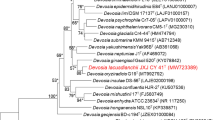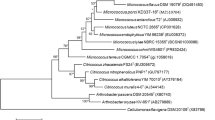Abstract
Attached bacteria of Microcystis play important roles in the occurence, outbreak and decline of Microcystis water blooms. In this study, a novel actinobacterium, designated strain JXJ CY 38 T, was isolated from the culture mass of Microcystis aeruginosa FACHB-905 (MAF), collected from Lake Dianchi, south-west, China. The strain was found to be a Gram-stain positive, short rod, catalase positive and oxidase negative. The isolate was found to be able to grow at 5.0–38.0 °C (optimum, 28.0 °C), pH 4.0–11.0 (optimum, 7.0–8.0) and 0–3.0% (w/v, optimum, 0%) NaCl. Based on 16S rRNA gene sequences, strain JXJ CY 38 T shows high similarities to Nocardioides furvisabuli JCM 13813 T (99.0%) and Nocardioides alpinus JCM 18960 T (98.7%), and less than 98.2% similarities to other members of the genus. The major cellular fatty acids (> 10.0%) were identified as iso-C16:0 (23.6%), C18:1ω9c (18.2%) and C17:1ω8c (16.4%), while the predominant menaquinone was found to be MK-8 (H4). The diagnostic diamino acids in the cell wall peptidoglycan were identified as aspartic acid, glutamic acid, glycine and alanine, with mannose, ribose and arabinose as whole cell sugars. The polar lipids were found to be diphosphatidylglycerol, phosphatidylglycerol, a phospholipid, phosphatidylcholine and an unidentified lipid. The DNA G + C content was determined to be 71.3%. The digital DNA-DNA hybridization and average nucleotide identity values between strain JXJ CY 38 T and the type strains N. furvisabuli JCM 13813 T and N. alpinus JCM 18960 T were 49.4% and 37.7%, and 92.0% and 83.4%, respectively. On the basis of the above taxonomic data and differences in physiological characteristics from the closely related type strains, strain JXJ CY 38 T was determined to represent a novel species of genus Nocardioides, for which the name Nocardioides lacusdianchii sp. nov. is proposed. The type strain is JXJ CY 38 T (= KCTC 49381 T = CGMCC 4.7665 T). Strain JXJ CY 38 T apparently exhibits complex effects on the interactions between MAF and other attached bacteria, including the promotion or inhibition of the growth of MAF and bacteria, and the synthesis and release of microcystins by MAF.



Similar content being viewed by others
Abbreviations
- ANI:
-
Average nucleotide identity
- BCS:
-
Binary culture system
- Chl-a :
-
Chlorophyll a
- dDDH:
-
Digital DNA-DNA hybridization
- E-MC-LR:
-
Extracellular microcystin LR
- I-MC-LR:
-
Intracellular microcystin LR
- MAF:
-
Microcystis aeruginosa FACHB-905
- TCS:
-
Ternary culture system
References
Bankevich A, Nurk S, Antipov D, Gurevich AA, Dvorkin M, Kulikov AS, Lesin VM, Nikolenko SI, Pham S, Prjibelski AD, Pyshkin AV, Sirotkin AV, Vyahhi N, Tesler G, Alekseyev MA, Pevzner PA (2012) SPAdes: a new genome assembly algorithm and its applications to single-cell sequencing. J Comput Biol 19:455–477
Casamatta D, Wickstrom C (2000) Sensitivity of two distinct bacterioplankton communities to exudates from the cyanobacterium Microcystis aeruginosa. Microb Ecol 41:64–73
Chun J, Oren A, Ventosa A, Christensen H, Arahal DR, da Costa MS, Rooney AP, Yi H, Xu XW, De Meyer S, Trujillo ME (2018) Proposed minimal standards for the use of genome data for the taxonomy of prokaryotes. Int J Syst Evol Microbiol 68:461–466
Dawson RM (1998) The toxicology of microcystins. Toxicon 36:953–962
de-Bashan LE, Antoun H, Bashan Y (2008) Involvement of indole-3-acetic-acid produced by the growth-promoting bacterium Azospirillum spp. in promoting growth of Chlorella vulgaris. J Phycol 44:938–947
Dziallas C, Grossart HP (2011) Temperature and biotic factors influence bacterial communities attached with the cyanobacterium Microcystis sp. Environ Microbiol 13:1632–1641
Felsenstein J (1985) Confidence limits on phylogenies: an approach using the bootstrap. Evolution 39:783–791
Fitch WM (1971) Toward defining the course of evolution: minimum change for a specific tree topology. Syst Zool 20:406–416
Kovacs N (1956) Identification of Pseudomonas pyocyanea by the oxidase reaction. Nature 178:703–704
Kumar S, Stecher G, Tamura K (2016) Mega 7: molecular evolutionary genetics analysis version 7.0 for bigger datasets. Mol Biol Evol 33:1870–1874
Lechevalier MP, Lechevalier HA (1970) Chemical composition as a criterion in the classifcation of aerobic actinomycetes. Int J Syst Bacteriol 20:435–443
Liu LP (1999) Characteristics of blue algal bloom in Dianchi Lake and analysis on its cause. Res Environ Sci 12:36–37
Liu YM, Chen W, Li DH, Shen YW, Liu YD, Song LR (2006) Analysis of paralytic shellfish toxins in Aphanizomenon DC–1 from Lake Dianchi, China. Environ Toxicol 21:289–295
Meier-Kolthoff JP, Auch AF, Klenk HP, Göker M (2013) Genome sequence–based species delimitation with confidence intervals and improved distance functions. BMC Bioinf 14:60
Minnikin DE, Collins MD, Goodfellow M (1979) Fatty acid and polar lipid composition in the classification of Cellulomonas, Oerskovia and related taxa. J Appl Bacteriol 47:87–95
Park MH, Chung IM, Ahmad A, Kim BH, Hwang SJ (2009) Growth inhibition of unicellular and colonial Microcystis strains (Cyanophyceae) by compounds isolated from rice (Oryza sativa) hulls. Aquat Bot 90:309–314
Peng G, Wang H, Zhang G, Hou W, Liu Y, Wang ET, Tan Z (2006) Azospirillum melinis sp. nov., a group of diazotrophs isolated from tropical molasses grass. Int J Syst Evol Microbiol 56:1263–1271
Saitou N, Nei M (1987) The neighbor–joining method: a new method for reconstructing phylogenetic trees. Mol Biol Evol 4:406–442
Seemann T (2014) Prokka: rapid prokaryotic genome annotation. Bioinformatics 30:2068–2069
Shi LM, Cai YF, Yang HL, Xing P, Li PF, Kong LD, Kong FX (2009) Phylogenetic diversity and specificity of bacteria attached with Microcystis aeruginosa and other cyanobacteria. J Environ Sci 21:1581–1590
Shieh WY, Chen YW, Chaw SM, Chiu HH (2003) Vibrio ruber sp. nov., a red, facultatively anaerobic, marine bacterium isolated from sea water. Int J Syst Evol Microbiol 53:479–484
Shirling EB, Gottlieb D (1966) Methods for characterization of Streptomyces species. Int J Syst Bacteriol 16:313–340
Smibert RM, Krieg NR (1994) Phenotypic characterization. In: Gerhardt P, Murray RGE, Wood WA, Krieg NR (eds) Methods for general and molecular bacteriology. American Society for Microbiology, Washington, DC, pp 607–654
Soon DL (2007) Nocardioides furvisabuli sp. nov., isolated from black sand. Int J Syst Evol Microbiol 57:35–39
Tamura K, Peterson D, Peterson N, Stecher G, Nei M, Kumar S (2011) MEGA5: molecular evolutionary genetics analysis using maximum likelihood, evolutionary distance, and maximum parsimony methods. Mol Biol Evol 28:2731–2739
Tang SK, Wang Y, Chen Y, Lou K, Cao LL, Xu LH, Li WJ (2009) Zhihengliuella alba sp. nov., and emended description of the genus Zhihengliuella. Int J Syst Evol Microbiol 59:2025–2032
Tindall BJ (1990) Lipid composition of Halobacterium lacusprofundi. FEMS Microbiol Lett 66:199–202
Valdor R, Aboal M (2007) Effects of living cyanobacteria, cyanobacterial extracts and pure microcystins on growth and ultrastructure of microalgae and bacteria. Toxicon 49:769–779
Xu P, Li WJ, Tang SK, Zhang YQ, Chen GZ, Chen HH, Xu H, Jiang CL (2005) Naxibacter alkalitolerans gen. nov., sp. nov., a novel member of the family Oxalobacteraceae isolated from China. Int J Syst Evol Microbiol 55:1149–1153
Yang LY, Xiao L (2011) Outburst, jeopardize and control of cyanobacterial bloom in lakes. Science Press, Beijing, China, p 212
Yoon SH, Ha SM, Kwon S, Lim J, Kim Y, Seo H, Chun J (2017) Introducing EzBiocloud: a taxonomically united database of 16S rRNA gene sequences and whole–genome assemblies. Int J Syst Evol Microbiol 67:1613–1617
Zhang BH, Chen W, Li HQ, Zhou EM, Hu WY, Duan YQ, Mohamad OA, Gao R, Li WJ (2015) An antialgal compound produced by Streptomyces jiujiangensis JXJ 0074T. Appl Microbiol Biotechnol 99:7673–7683
Zhang BH, Salam N, Cheng J, Li HQ, Yang JY, Zha DM, Guo QG, Li WJ (2017) Microbacterium lacusdiani sp. nov., a phosphate–solubilizing novel actinobacterium isolated from mucilaginous sheath of Microcystis. J Antibiot 70:147–151
Zhang BH, Salam N, Cheng J, Li HQ, Yang JY, Zha DM, Zhang YQ, Ai MJ, Hozzein WN, Li WJ (2016) Modestobacter lacusdianchii sp nov, a phosphate-solubilizing actinobacterium with ability to promote Microcystis growth. Plos One 11:e0161069
Zhang BH, Salam N, Cheng J, Xiao M, Li HQ, Yang JY, Zha DM, Li WJ (2016b) Citricoccus lacusdiani sp. nov., an actinobacterium promoting Microcystis growth with limited soluble phosphorus. Antonie Van Leeuwenhoek 109:1457–1465
Zhang DC, Schumann P, Redzic M, Zhou YG, Liu HC, Schinner F, Margesin R (2012) Nocardioides alpinus sp. nov., a psychrophilic actinomycete isolated from alpine glacier cryoconite. Int J Syst Evol Microbiol 62:445–450
Funding
This research was supported by National Natural Science Foundation of China (NO. 31060010) and Program of Jiujiang University (No. 201511).
Author information
Authors and Affiliations
Contributions
BZ designed the experiments; YX, LW, XW, MC and JC performed the experiments; YX, BZ and BT analyzed the data; YX and BZ drafted and revised the manuscript. All authors have read and approved the final version of the manuscript.
Corresponding author
Ethics declarations
Conflict of interest
The authors declare no conflict of interest.
Ethical approval
This article does not contain any studies with human participants and/or animals performed by any of the authors.
Additional information
Publisher's Note
Springer Nature remains neutral with regard to jurisdictional claims in published maps and institutional affiliations.
Supplementary Information
Below is the link to the electronic supplementary material.
Rights and permissions
About this article
Cite this article
Xiao, Y., Wang, L., Wang, X. et al. Nocardioides lacusdianchii sp. nov., an attached bacterium of Microcystis aeruginosa. Antonie van Leeuwenhoek 115, 141–153 (2022). https://doi.org/10.1007/s10482-021-01690-9
Received:
Accepted:
Published:
Issue Date:
DOI: https://doi.org/10.1007/s10482-021-01690-9




